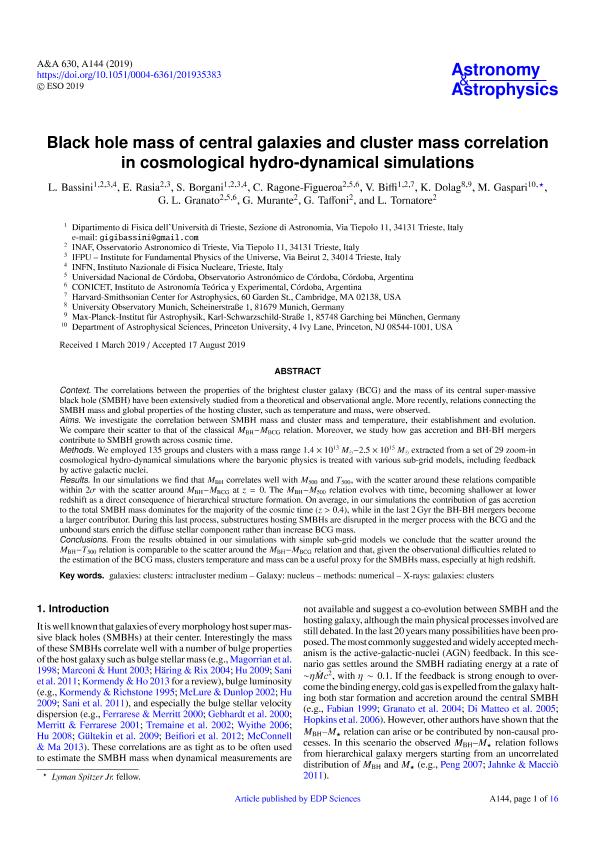Mostrar el registro sencillo del ítem
dc.contributor.author
Bassini, L.
dc.contributor.author
Rasia, E.
dc.contributor.author
Borgani, S.
dc.contributor.author
Ragone Figueroa, Cinthia Judith

dc.contributor.author
Biffi, V.
dc.contributor.author
Dolag, K.
dc.contributor.author
Gaspari, M.
dc.contributor.author
Granato, Gian Luigi

dc.contributor.author
Murante, G.
dc.contributor.author
Taffoni, G.
dc.contributor.author
Tornatore, L.
dc.date.available
2020-12-16T19:37:49Z
dc.date.issued
2019-10
dc.identifier.citation
Bassini, L.; Rasia, E.; Borgani, S.; Ragone Figueroa, Cinthia Judith; Biffi, V.; et al.; Black hole mass of central galaxies and cluster mass correlation in cosmological hydro-dynamical simulations; EDP Sciences; Astronomy and Astrophysics; 630; 10-2019; 1-16
dc.identifier.issn
0004-6361
dc.identifier.uri
http://hdl.handle.net/11336/120609
dc.description.abstract
The correlations between the properties of the brightest cluster galaxy (BCG) and the mass of its central super-massive black hole (SMBH) have been extensively studied from a theoretical and observational angle. More recently, relations connecting the SMBH mass and global properties of the hosting cluster, such as temperature and mass, were observed. Aims. We investigate the correlation between SMBH mass and cluster mass and temperature, their establishment and evolution. We compare their scatter to that of the classical MBH-MBCG relation. Moreover, we study how gas accretion and BH-BH mergers contribute to SMBH growth across cosmic time. Methods. We employed 135 groups and clusters with a mass range 1.4 × 1013 M⊙- 2.5 × 1015 M⊙ extracted from a set of 29 zoom-in cosmological hydro-dynamical simulations where the baryonic physics is treated with various sub-grid models, including feedback by active galactic nuclei. Results. In our simulations we find that MBH correlates well with M500 and T500, with the scatter around these relations compatible within 2σ with the scatter around MBH - MBCG at z = 0. The MBH - M500 relation evolves with time, becoming shallower at lower redshift as a direct consequence of hierarchical structure formation. On average, in our simulations the contribution of gas accretion to the total SMBH mass dominates for the majority of the cosmic time (z > 0.4), while in the last 2 Gyr the BH-BH mergers become a larger contributor. During this last process, substructures hosting SMBHs are disrupted in the merger process with the BCG and the unbound stars enrich the diffuse stellar component rather than increase BCG mass. Conclusions. From the results obtained in our simulations with simple sub-grid models we conclude that the scatter around the MBH - T500 relation is comparable to the scatter around the MBH - MBCG relation and that, given the observational difficulties related to the estimation of the BCG mass, clusters temperature and mass can be a useful proxy for the SMBHs mass, especially at high redshift.
dc.format
application/pdf
dc.language.iso
eng
dc.publisher
EDP Sciences

dc.rights
info:eu-repo/semantics/openAccess
dc.rights.uri
https://creativecommons.org/licenses/by-nc-sa/2.5/ar/
dc.subject
GALAXIES: CLUSTERS: INTRACLUSTER MEDIUM
dc.subject
GALAXY: NUCLEUS
dc.subject
METHODS: NUMERICAL
dc.subject
X-RAYS: GALAXIES: CLUSTERS
dc.subject.classification
Astronomía

dc.subject.classification
Ciencias Físicas

dc.subject.classification
CIENCIAS NATURALES Y EXACTAS

dc.title
Black hole mass of central galaxies and cluster mass correlation in cosmological hydro-dynamical simulations
dc.type
info:eu-repo/semantics/article
dc.type
info:ar-repo/semantics/artículo
dc.type
info:eu-repo/semantics/publishedVersion
dc.date.updated
2020-11-19T21:24:44Z
dc.identifier.eissn
1432-0746
dc.journal.volume
630
dc.journal.pagination
1-16
dc.journal.pais
Francia

dc.description.fil
Fil: Bassini, L.. Università degli Studi di Trieste; Italia. Institute for Fundamental Physics of the Universe; Italia
dc.description.fil
Fil: Rasia, E.. Institute for Fundamental Physics of the Universe; Italia. Osservatorio Astronomico Di Trieste, Italia; Italia
dc.description.fil
Fil: Borgani, S.. Institute for Fundamental Physics of the Universe; Italia. Università degli Studi di Trieste; Italia. Instituto Nazionale di Fisica Nucleare; Italia
dc.description.fil
Fil: Ragone Figueroa, Cinthia Judith. Osservatorio Astronomico Di Trieste, Italia; Italia. Consejo Nacional de Investigaciones Científicas y Técnicas. Centro Científico Tecnológico Conicet - Córdoba. Instituto de Astronomía Teórica y Experimental. Universidad Nacional de Córdoba. Observatorio Astronómico de Córdoba. Instituto de Astronomía Teórica y Experimental; Argentina
dc.description.fil
Fil: Biffi, V.. Università degli Studi di Trieste; Italia. Harvard-Smithsonian Center for Astrophysics; Estados Unidos. University Observatory Munich,; Alemania
dc.description.fil
Fil: Dolag, K.. Gobierno de la República Federal de Alemania. Max Planck Institut für Astrophysik; Alemania. Ludwig Maximilians Universitat; Alemania
dc.description.fil
Fil: Gaspari, M.. University of Princeton; Estados Unidos
dc.description.fil
Fil: Granato, Gian Luigi. Osservatorio Astronomico Di Trieste, Italia; Italia
dc.description.fil
Fil: Murante, G.. Osservatorio Astronomico Di Trieste, Italia; Italia
dc.description.fil
Fil: Taffoni, G.. Osservatorio Astronomico Di Trieste, Italia; Italia
dc.description.fil
Fil: Tornatore, L.. Osservatorio Astronomico Di Trieste, Italia; Italia
dc.journal.title
Astronomy and Astrophysics

dc.relation.alternativeid
info:eu-repo/semantics/altIdentifier/doi/http://dx.doi.org/10.1051/0004-6361/201935383
Archivos asociados
